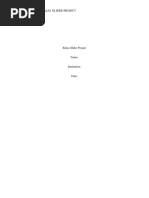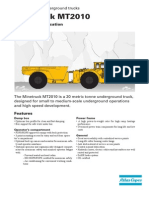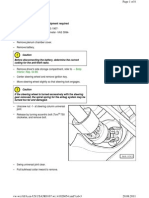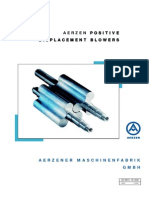Final Report Formatted
Uploaded by
api-309598794Final Report Formatted
Uploaded by
api-309598794L3 Applications Final Report
Group 13
Students: Jek-Kai Tan
Shiuh Sheng Tan
Patricia Tam
Will Taylor
Marcus Teo
Jan Tomaszewski
Masha Valkova
Academic Supervisor: Dr Mirko Kovac
Submission Date: 22/2/2016
Department: Aeronautics
Course: H401 Aeronautical Engineering
Subject: AE418 Applications Exercise
Website: http://theglidebot13.weebly.com/
Group 13
L3 Final Report
Introduction
This project requires us to design and build a
small remote-controlled robot that could
accelerate along a variable incidence ramp
and launch into a glide, with the aim of
maximising its range. A number of limitations
were posed, such as maximum mass of 50g,
maximum dimension of 400mm. The
electronic components were pre-defined, and
the available materials were limited to carbon
rods, mylar film, depron, acetal and acrylic
sheets.
Modelling
Ramp Phase
We started with a simple free body diagram
(Figure 1) to determine forces acting on the
robot whilst driving up the ramp. Later, more
complexity was added to the model including
gear efficiency, wheel traction, and drag. It
was assumed that maximum torque and rpm
scaled linearly with voltage and that the output
of the motor was 3.5 V after losses. A Matlab
script was written to determine the optimal
configuration and a simple time-marching
method was used to obtain the final velocity at
the end of the ramp:
= /
(1)
The script was run for ramp angles ranging
from 0 to 30 and wheel diameters ranging
from 3 to 6 cm. The highest speeds were
obtained with wheel diameters larger than 5cm
and a motor with a 10:1 gear ratio. But due to
the weight penalty of large wheels, it was
decided that the 5:1 motor and smaller 3.2cm
wheels would be used as they were only
marginally slower. A 20 tooth involute gear
was chosen based on the gear diameter and
efficiency required for our design.
Glide Phase
The trajectory model accounts for the total
weight of the robot, and the wing lift and drag
(Figure 2), assuming perfect static stability. A
flat plate approximation is used for the wing
(Equation 3), while a drag coefficient of a long
cylinder is assumed (Equation 5).
= 1/2 2
= 2
= 1/2 2
0.8
= 1/ ( sin cos )
= 1/ ( sin cos )
(2)
(3)
(4)
(5)
(6)
(7)
22 February 2016
By integration, the velocity, displacement, lift
and drag are updated for each time step until
we obtained the full trajectory.
We anticipated that a stability model would
involve a lot of inaccurate due to the difficulty
in estimating component CG and centre of lift
positions. So in practice it was obtained
through experimentation, for which our
modular design with sliding components was
very well suited.
Design and Manufacturing
Considering the weight and size restrictions,
we took inspiration from small RC planes for
ease of manufacturing and a simple design.
The final design was a tail dragger glider with
2 main wheels and a tail wheel (Figure 4).
Wing and Tail
We initially tried to manufacture cambered
wings but due to the complexity of
manufacturing, a simple flat plate wing design
was chosen. After several iterations, we
obtained a wing that could be successfully
manufactured with the materials and
processes available. Analysing initial wings
produced by us and other teams revealed that
wing area must be maximised to produce
enough lift at these ultra-low Reynolds.
Taking inspiration from the flying squirrel, we
constructed a rectangular wing from a mylar
sheet stretched between two carbon rods.
This setup was light and presented an
advantage over other teams, allowing the
mylar sheet to inflate slightly during glide
therefore developing camber, and hence extra
lift.
During the development stage, both the tail
and the wing incorporated a variable angle of
attack mechanism and an adjustable
longitudinal position for seamless testing.
Through trials, it was determined that varying
the longitudinal position was sufficient to
obtain good performance. However, in the
limited time available, we werent able to fully
study the effect of varying the wing and tail
setting angles, so they were kept at 0, which
reduced weight and manufacturing complexity.
Chassis
Since maximising wing area was prioritised,
weight limits didnt permit us to enclose the
electrical components inside a housing. The
Group 13
L3 Final Report
wing and tail are attached via two carbon rods
to the base plate.
Acetal and acrylic were considered for the
construction of the base. While acrylic is less
dense, it was found to be too brittle and
fractured after several tests. Therefore we
settled for an acetal base with cut-outs to
reduce weight and to prevent fracture, while
still maintaining optimum mass.
The motor, main wheels, circuit board, and
battery were mounted on the base plate. The
motor was mounted with its drive shaft on the
starboard side of the robot, and drives the
main axle through a 20 tooth gear. The axle
was threaded through two bearings mounted
on the underside of the baseplate with laser
cut mounts.
Results Analysis and Improvements
Final Test Results
At the final test our glider landed 3.64m from
the foot of the ramp, which compares
reasonably well with our theoretical prediction.
However previous tests of the glider achieved
a maximum distance of 4.2m, so the full
potential of our design wasnt demonstrated
on the test day, and this is due to the extremely
low static margin, making stability very
sensitive to CG and wing aerodynamic centre.
It is therefore recommended to increase the
static margin in future.
Aerodynamic and Structural Design
As seen in Figure 3, our code predicts better
performance at higher ramp incidences. But in
practice, issues were encountered with the
power of the motor and the tail hitting the ramp
after lift-off, so the glider was optimised for a 0
ramp. Thus in future, we would like incorporate
a design with a raised tail and a more powerful
motor to allow the use of higher ramp angles.
We would also like to explore the effect of
varying the wing setting angle to determine the
optimum design.
Even though our Matlab model was very basic,
it proved to be a good benchmark. We
outperformed its prediction several times,
which indicates our assumed drag coefficient
and the flat plate lift approximation were overly
conservative. The flat plate lift approximation
is used to approximate the lift coefficient for
our glider, even though our wing design is
capable of developing camber to further aid
the production of lift.
22 February 2016
In future, we would also improve component
placement to increase the static margin and
introduce a streamlined housing to reduce
drag. Areas such as the gears and possibly
baseplate have been identified as locations
where material can be removed for further
weight saving. Additionally, since tests
suggested that the tail section had negligible
lift and produced a nose-up pitching moment,
we would also explore whether we could
replace the tail with a simple counterweight.
Drivetrain Design
As the driving gear was mounted on the right
of the model, this caused the model to veer
slightly to the left due to a torque imbalance at
the wheels. In the end, adding a rubber O-ring
to the tail wheel provided the required
directional stability and allowed the robot to go
in a straight line. In future, bevel gears could
be used to allow the drive gear to be mounted
in the centre, mitigating the issue of torque
steer. This ensures that our robot glider would
remain in a straight path when accelerating up
a ramp.
In addition, measurements of the end-of-ramp
speed can be taken to improve the
mathematical
model
of
the
gliders
acceleration on the ramp.
Conclusion
In conclusion, our prototype of a jump-glider
turned out to be a very successful concept.
The mathematical model used managed to
predict the performance of our model
accurately after some refinement.
Designing the robot in a modular fashion
allowed us to adjust the most important
parameters such as the angle of attack, CG
position and the static margin. Despite initial
issues with rigidity of manufactured parts, the
design evolved into a lightweight, stiff structure
that could rapidly propel up the ramp, glide and
survive the landing impact with no significant
damage. The optimum set-up obtained
allowed us to achieve a glide range of 3.64m.
Finally, it was predicted that higher ramp angle
would yield even better results. Hence, if we
were to improve the current concept, it would
feature a raised-tail design with more
streamlined body shape and even more
extreme cut-outs to retain the weight below 50
grams. This should give us an improved range
of 5-6m.
Group 13
L3 Final Report
22 February 2016
Figures
Figure 1: Free-body diagram of glider on ramp
Figure 2: Glide free body diagram [1]
Figure 3: Comparison between predicted trajectory and actual results suggests
underestimation of CL and overestimation of CD
Figure 4: CAD model of the robot-glider
References
[1] Bishop K. Aerodynamic force generation, performance and control of body orientation during
gliding in sugar gliders (Petaurus breviceps), Journal of Experimental Biology, 2007. Available from:
http://jeb.biologists.org/content/210/15/2593 [Last accessed: 21st February 2016]
3
You might also like
- Perforadora Diamantina DB525 - OM - 20081002D100% (2)Perforadora Diamantina DB525 - OM - 20081002D165 pages
- Glider Design Project Introduction To AeNo ratings yetGlider Design Project Introduction To Ae15 pages
- B. E. Project Report RC Plane: Chandigarh University, Gharuan, Mohali, PunjabNo ratings yetB. E. Project Report RC Plane: Chandigarh University, Gharuan, Mohali, Punjab16 pages
- Glider Design Project: ME 628 Fall 2012 Team A5100% (1)Glider Design Project: ME 628 Fall 2012 Team A516 pages
- Sae Aero Design West Report, Polytechnic Institute of NYU, 213 PDFNo ratings yetSae Aero Design West Report, Polytechnic Institute of NYU, 213 PDF30 pages
- Design and Fabrication of Radio Controlled N-Chia Drone For SurveillanceNo ratings yetDesign and Fabrication of Radio Controlled N-Chia Drone For Surveillance4 pages
- Laboratory Session IV: Glider Design and Performance: Universidad Carlos III de MadridNo ratings yetLaboratory Session IV: Glider Design and Performance: Universidad Carlos III de Madrid6 pages
- Nguyen Hoang Minh Hieu - Design and Build a Glider100% (1)Nguyen Hoang Minh Hieu - Design and Build a Glider9 pages
- GAMAFORCE (Gadjah Mada Flying Object Research Center)No ratings yetGAMAFORCE (Gadjah Mada Flying Object Research Center)25 pages
- The Design Development and Testing of A PDFNo ratings yetThe Design Development and Testing of A PDF109 pages
- The Design Development and Testing of ANo ratings yetThe Design Development and Testing of A109 pages
- Diy Project Report On Glider Team 5: Indian Institute of Technology KharagpurNo ratings yetDiy Project Report On Glider Team 5: Indian Institute of Technology Kharagpur11 pages
- Sae Aero Design Report: FAMU-FSU College of Engineering Team #37No ratings yetSae Aero Design Report: FAMU-FSU College of Engineering Team #3739 pages
- Indian Institute of Technology Kharagpur: DIY Project Team 5No ratings yetIndian Institute of Technology Kharagpur: DIY Project Team 512 pages
- A Little Balsa Glider With A Good YieldNo ratings yetA Little Balsa Glider With A Good Yield13 pages
- Reverse Engineering and Aerodynamic Analysis of A Flying Wing UAV ATSChandranNo ratings yetReverse Engineering and Aerodynamic Analysis of A Flying Wing UAV ATSChandran13 pages
- S823 Airfoil: Flluid Mechanics D MechanicsNo ratings yetS823 Airfoil: Flluid Mechanics D Mechanics13 pages
- Design and Fabrication of Fixed Unmanned Aerial VehicleNo ratings yetDesign and Fabrication of Fixed Unmanned Aerial Vehicle27 pages
- UNMANNED_AERIAL_VEHICLE_UAV_AUTOPILOT_SYNo ratings yetUNMANNED_AERIAL_VEHICLE_UAV_AUTOPILOT_SY90 pages
- High Speed Off-Road Vehicles: Suspensions, Tracks, Wheels and DynamicsFrom EverandHigh Speed Off-Road Vehicles: Suspensions, Tracks, Wheels and DynamicsNo ratings yet
- Me6411 Manufacturing Technology-II Lab ManualNo ratings yetMe6411 Manufacturing Technology-II Lab Manual35 pages
- Performance Test Method For Intensive Use ChairsNo ratings yetPerformance Test Method For Intensive Use Chairs21 pages
- Third Term jss2 Basic Technology - 081916No ratings yetThird Term jss2 Basic Technology - 08191625 pages
- Systematic Approachto Designing Plastic Purand:eical Gears: Raymond M. Paquet Manchester, CTNo ratings yetSystematic Approachto Designing Plastic Purand:eical Gears: Raymond M. Paquet Manchester, CT14 pages
- Automotive Component Manufacturers in INDIA: SL - No Company Contact Information Product / Services State Comments100% (1)Automotive Component Manufacturers in INDIA: SL - No Company Contact Information Product / Services State Comments8 pages
- Effect of Rotational Speed On The Performance of Unreinforced andNo ratings yetEffect of Rotational Speed On The Performance of Unreinforced and8 pages
- JNTUK Agricultural Engineering R16 SyllabusNo ratings yetJNTUK Agricultural Engineering R16 Syllabus91 pages
- BUL - PNEUDRI - MX - US - 052019 CompresorNo ratings yetBUL - PNEUDRI - MX - US - 052019 Compresor14 pages
- des_2023-10-17-10-51-52_ed2a27349fe0bec1f54862bc46208da0No ratings yetdes_2023-10-17-10-51-52_ed2a27349fe0bec1f54862bc46208da048 pages
- B. E. Project Report RC Plane: Chandigarh University, Gharuan, Mohali, PunjabB. E. Project Report RC Plane: Chandigarh University, Gharuan, Mohali, Punjab
- Sae Aero Design West Report, Polytechnic Institute of NYU, 213 PDFSae Aero Design West Report, Polytechnic Institute of NYU, 213 PDF
- Design and Fabrication of Radio Controlled N-Chia Drone For SurveillanceDesign and Fabrication of Radio Controlled N-Chia Drone For Surveillance
- Laboratory Session IV: Glider Design and Performance: Universidad Carlos III de MadridLaboratory Session IV: Glider Design and Performance: Universidad Carlos III de Madrid
- Nguyen Hoang Minh Hieu - Design and Build a GliderNguyen Hoang Minh Hieu - Design and Build a Glider
- GAMAFORCE (Gadjah Mada Flying Object Research Center)GAMAFORCE (Gadjah Mada Flying Object Research Center)
- Diy Project Report On Glider Team 5: Indian Institute of Technology KharagpurDiy Project Report On Glider Team 5: Indian Institute of Technology Kharagpur
- Sae Aero Design Report: FAMU-FSU College of Engineering Team #37Sae Aero Design Report: FAMU-FSU College of Engineering Team #37
- Indian Institute of Technology Kharagpur: DIY Project Team 5Indian Institute of Technology Kharagpur: DIY Project Team 5
- Reverse Engineering and Aerodynamic Analysis of A Flying Wing UAV ATSChandranReverse Engineering and Aerodynamic Analysis of A Flying Wing UAV ATSChandran
- Design and Fabrication of Fixed Unmanned Aerial VehicleDesign and Fabrication of Fixed Unmanned Aerial Vehicle
- High Speed Off-Road Vehicles: Suspensions, Tracks, Wheels and DynamicsFrom EverandHigh Speed Off-Road Vehicles: Suspensions, Tracks, Wheels and Dynamics
- Worked Examples in Mechanics of Machines using MATLABFrom EverandWorked Examples in Mechanics of Machines using MATLAB
- Systematic Approachto Designing Plastic Purand:eical Gears: Raymond M. Paquet Manchester, CTSystematic Approachto Designing Plastic Purand:eical Gears: Raymond M. Paquet Manchester, CT
- Automotive Component Manufacturers in INDIA: SL - No Company Contact Information Product / Services State CommentsAutomotive Component Manufacturers in INDIA: SL - No Company Contact Information Product / Services State Comments
- Effect of Rotational Speed On The Performance of Unreinforced andEffect of Rotational Speed On The Performance of Unreinforced and
- des_2023-10-17-10-51-52_ed2a27349fe0bec1f54862bc46208da0des_2023-10-17-10-51-52_ed2a27349fe0bec1f54862bc46208da0

























































































